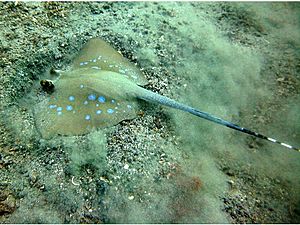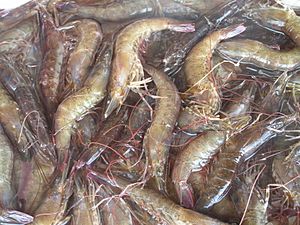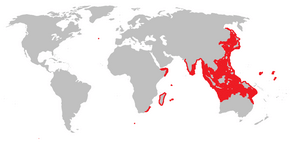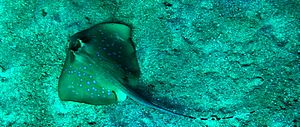Kuhl's maskray facts for kids
Quick facts for kids Kuhl's maskray |
|
|---|---|
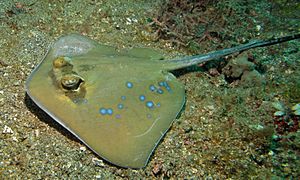 |
|
| Conservation status | |
| Scientific classification | |
| Genus: |
Neotrygon
|
| Species: |
kuhlii
|
The bluespotted stingray (Neotrygon kuhlii) is also known as the bluespotted maskray or Kuhl's stingray. It is a type of stingray found in the ocean. In 2008, scientists changed its name from Dasyatis kuhlii to Neotrygon kuhlii. This happened after they studied its body and DNA.
This ray has a flat, diamond-shaped body. It is green with bright blue spots. The widest part of its body can be about 46.5 centimeters (18 inches) across. Bluespotted stingrays are popular in aquariums. However, they are often confused with the bluespotted ribbontail ray. The ribbontail ray has a rounder body and brighter colors. But the bluespotted stingray is generally larger. Female bluespotted stingrays can live for about 13 years, while males live for about 10 years. These rays eat many small fish and other sea creatures. They live in waters from Indonesia to Japan and most of Australia.
Contents
About the Bluespotted Stingray
The bluespotted stingray was first found by Heinrich Kuhl in Java, Indonesia. The group of rays it belongs to, Neotrygon, are called maskrays. This is because of the cool color patterns around their eyes.
Appearance and Behavior
The bluespotted stingray has a flat, diamond-shaped body. It can grow up to 47 centimeters (18.5 inches) wide. Its total length, including its tail, can reach about 70 centimeters (27.5 inches). Their bodies are dark green with blue spots. Their bellies are light white, which is a type of camouflage called countershading. This helps them blend in with the light from the surface when seen from below.
The ray's snout is short and angled. Its bright colors act as a warning sign because it has venomous spines. The ray has a very long tail, about twice the length of its body. At the base of the tail are two venomous spines. One spine is very large, and the other is medium-sized.
Bluespotted stingrays have bright yellow eyes. These eyes are placed to give them a wide view of their surroundings. Their gills are on the underside of their body. So, they use special openings called spiracles to breathe. These spiracles are right behind their eyes. They let water reach the gills when the ray is resting or eating on the seafloor. The mouth is also on the underside of the body. This helps them find food on the bottom.
Rays usually live alone, but sometimes they can be seen in groups. A unique thing about the bluespotted stingray is that it rarely buries itself in the sand. It only does this to hide from predators. Most other stingrays bury themselves often to hunt.
What They Eat
The bluespotted stingray eats shrimp, small fish, mollusks, crabs, and worms. Since it feeds on the shallow seafloor, it has a limited variety of food. The stingray catches its prey by pinning it to the seafloor with its fins. It has many tiny teeth. The lower jaw is slightly curved. Like most stingrays, they also have flat, plate-like teeth. These teeth help them crush their prey.
Reproduction and Life Cycle
The bluespotted stingray is ovoviviparous. This means the mother keeps the eggs inside her body until the babies are ready to hatch. The young rays get food from a special fluid inside the mother. Mothers give birth to up to seven pups at a time. These pups are about 6 to 13 inches (15 to 33 cm) long when they are born.
Female bluespotted stingrays have babies once a year. Studies show that they mate in October and November. The eggs develop during the Australian summer (December to February).
Where They Live
The bluespotted stingray usually lives in waters that are about 0 to 90 meters (0 to 295 feet) deep. They are often found in sandy or muddy areas. But they can also be seen near rocky coral reefs and seagrass beds. These stingrays prefer warm, tropical climates.
You can find them in northern Australia, Kenya, Madagascar, the island of Mauritius, Somalia, and the east coast of South Africa. They also live in India and almost all the coastal waters of Asia. This includes the Sea of Japan, Yellow Sea, East China Sea, Philippine Sea, Sulu Sea, Java Sea, Banda Sea, Celebes Sea, Andaman Sea, the Bay of Bengal, and the Arabian Sea. At high tide, the bluespotted stingray moves into shallow lagoons and reef flats.
Threats and Protection
In Queensland, Australia, there are special areas that protect the bluespotted stingray. These include the Shoalwater and Corio Bay's Area Ramsar Site, and the Great Barrier Reef Marine Park.
A big danger to the bluespotted stingray is the damage to coral reefs. This is especially true in the northwest Pacific. These rays live in these reefs. Pollution from fertilizers and pesticides also harms them. Fishermen often catch these rays in the Java Sea using trawling and Danish seine boats. The bluespotted stingray is one of the most caught types of rays. In 2006-2007, about 700 kilograms (1,540 pounds) of them were caught per boat.
Who Hunts Them
Larger ocean animals, like hammerhead sharks, sometimes hunt the bluespotted stingray. The ray's bright colors warn predators about its very venomous spines. Because of this, not many animals try to attack this ray. A hammerhead shark might use its head to pin down the stingray. This can make the ray go into shock and become weaker.
Interaction with Humans
The bluespotted stingray is often kept as a pet in aquariums. However, many people don't realize that these rays grow very large. They often become too big for most home aquariums.
People also fish for bluespotted stingrays for their meat. The meat is often smoked, salted, or dried for local markets. It is not very expensive because the ray is small. They are caught using bottom trawls, trammel nets, and fish traps.
The bluespotted stingray is very venomous. It has a barb that can be about 12 inches (30 cm) long. Its venom contains several chemicals that can cause pain and other effects.
The skin of the bluespotted stingray is also used to make drums. For example, it is used on Arab and Turkish darbuka goblet drums and riq (def) tambourines.
Parasites
The bluespotted stingray can have many different parasites. These include various types of tapeworms, flatworms, and flukes.



